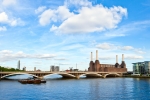The Victorian-style metal railings which surround the park have been restored at a cost of £90,000 – using funds generated when the park hosted the Formula E electric motor car racing events.
Cllr Sutters (centre) inspects progress alongside the chairman of the Friends of Battersea Park Frances Radcliffe
As a result of hosting the events for two years, the park is having £500,000 invested in a range of improvements using funds paid by the race organisers. In overall terms, staging the races over two weekends in 2015 and 2016 raised a total of £3m for local taxpayers, providing a much needed cash boost for local frontline services.
The refurbishment of these heritage railings was a project that had been long-wished for – but for which funding did not previously exist.
This is just one project that Battersea Park is benefiting from, largely paid for using Formula E income.
In total improvements worth £840,000 are now being implemented in the park. This sum includes £250,000 levied from the developers of the neighbouring Battersea Wharf and Chelsea Bridge Wharf housing schemes, while a further generous sum of £70,000 was received from local amenity group The Friends of Battersea Park.
The projects include:
Provision of a new playground near the lakeside café – Located just off East Carriage Drive near the café and boating lake, £150,000 has been spent on providing new play equipment suitable for children up the age of 12.
Providing a new park entrance – A new pedestrian entrance between Chelsea and Rosary Gates, with associated landscaping, has opened allowing this new access route to connect with existing paths near the Millennium Arena.
The new Promontory Garden – This new riverside garden has just been officially opened. Located some 50 metres east of Albert Bridge this new public attraction sits on a piece of embankment that juts out 12 metres into the Thames, which historical records suggest has always been fenced off from the main part of the park since its construction in the mid -1850s and been closed to the public for many decades. Now a landmark feature of the park it offers seating and unrivalled views of the Thames and in particular Albert Bridge.
Cascade fountain feasibility and restoration project – The cascades are an important and prominent historic landscape feature, but over time they have deteriorated and can no longer be used without causing significant additional damage. Money has been set aside to initially explore, and if feasible, fund their complete refurbishment.
Restoration of seating shelters – Three historic Victorian-era shelters have been restored and fitted with new seating along with structural and decorative renovation.

The newly created Promontory Garden
Parks and open spaces spokesman Cllr Steffi Sutters said: “The new railings look magnificent. I’m absolutely delighted that we have been able to restore them and ensure they continue to look good for future generations of park visitors.
“Fortunately we were able to carry out this project, and fund many others in the park thanks largely to the income we received from Formula E. This has contributed £500,000 towards improvements in the park, plus another £2.5m on other important frontline services across Wandsworth.
“Thanks to this money we have been able to deliver a range of improvements that will be enjoyed by visitors for many, many years to come.”
The refurbishment project coincides with Wandsworth’s “Love Parks” campaign which is championing the borough’s green spaces to encourage more people to visit and enjoy them.
Battersea Park covers some 200 acres and was opened by Queen Victoria in March 1858 having been created out of fields and marshland to create a place of healthy recreation for the huge numbers of people who had moved to London during the Industrial Revolution.
It was designed by the famous Victorian engineer James Pennethorne and the planting overseen by legendary adventurer John Gibson, who scoured the four corners of the globe for exotic plants to display in the park's famous sub-tropical garden, the first of its kind to open to the British public.
Throughout the 20th century, much of the original horticultural diversity was lost, largely due to the impact of two world wars when the park was not only used for allotments and pig farming, but also for troop dispersal areas, bomb shelters and anti-aircraft gun emplacements. The park also suffered extensive bomb damage from Luftwaffe bombers on missions to disable neighbouring Battersea Power Station, as well as being hit towards the end of the war by a V1 rocket.
In 1951 the park was chosen as the home for the Festival of Britain Pleasure Gardens, designed by Russell Page. A permanent funfair was also included, which for many years proved enormously popular with people of all ages, but which eventually closed in 1974.
Under the stewardship of the Greater London Council, the park became somewhat rundown in the 1970s and 80s and it was eventually taken over by Wandsworth in 1986 when the GLC was abolished. Since then, millions of pounds have been spent transforming it into today’s popular and much-loved open space.
For more information about the park and its attractions visit www.wandsworth.gov.uk/batterseapark.


